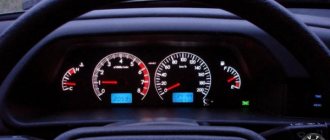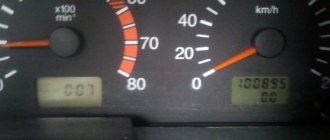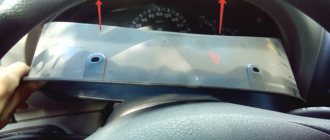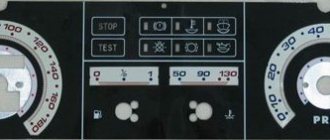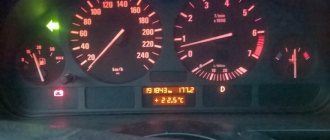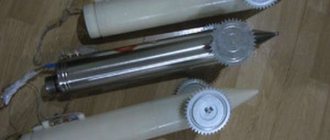What should you do if a yellow exclamation mark lights up on your car's dashboard? This question often worries car owners. It is sometimes difficult to give an unambiguous answer to this, because in cars of different brands the same problems can be displayed on the display using different signs. This means that you will have to carefully understand them so as not to find yourself at some point in a hopeless, or rather, hopeless situation.
How do indicators work differently in cars with and without ABS?
If the car has the named system, then the warning lamp (also called the indicator icon) should normally light up when the ignition is turned on and the parking brake is applied, and go out after starting the engine and when the parking brake is released. This is how the system is tested. And if the light goes out, it means the system is working properly. An indicator signal that glows longer than expected indicates a malfunction in the vehicle's systems. If ABS is not installed, then when the ignition is turned on, the icon appears only if problems arise, which we will discuss in more detail below.
So what could be causing the exclamation mark?
As we have already said, several exclamation marks can appear on the dashboards of different car brands. For example: in the yellow triangle - a signal of a malfunction in the electronic stabilization system, or in the red - the occurrence of an emergency situation, in brackets - a sign of low tire pressure (we are mostly talking about American-made cars). And if everything is clear enough with the last warning symbol, then an exclamation mark in a circle that appears on your dashboard and does not disappear during the trip may be a signal of several different problems:
- lack of brake fluid;
- violation of the integrity of the indicator circuit;
- leakage of the vacuum brake booster;
- putting the parking brake into working condition.
By the way, when the anti-lock braking system fails, the warning lights for both the brake system and ABS light up!
What does the exclamation mark on the instrument panel mean?
If there are several indicators with exclamation marks on the panel of a car model, then they all differ in visual design. For example, an indicator of air pressure in wheels can be designed as an exclamation mark in a wheel, an indicator of technical malfunction of various components in a gear, etc.
The oil level in the engine crankcase is the most important parameter. When driving with low or no oil, the engine will fail in a matter of minutes. Therefore, cars and tractors have been equipped with oil level sensors for a long time, long before the advent of electronic sensors.
Don't forget about the information on the scoreboard!
By the way, in any case, the signs appearing on the panel are also a reason to find out the reason for the warning on the information board itself. To better understand the problem, you should open the “Machine Information” section there. To do this, you need to enter the menu and, by switching up or down, confirm your choice. This way you can find out what exactly the illuminated danger sign is telling you. As already mentioned, in some cars the exclamation mark can indicate not only defects in the brake system; in such cases, a description of the malfunction is displayed on the message display in the center of the dashboard.
How does the indicator light up when there is a lack of brake fluid?
So, to begin with, let's assume that the indicator reports insufficient brake fluid level. If this problem appears in your car, then an exclamation mark lights up on the display even while driving. Check if everything is in order and add fuel fluid if necessary. However, you should remember that later, when you have to change the pads, it can rise in the reservoir and spill. Be careful, try to suck her off with something. A rubber bulb may also be suitable for this.
The exclamation mark on the instrument panel lights up
More modern models with an on-board computer are capable of more extensive testing of the condition of the braking system. For example, not only the brake fluid level, but also worn out pads, their sticking, handbrake malfunctions, etc. In any case, the signal warns the driver of problems.
Therefore, when it turns on, it is safer to stop driving. Even if the signal turns on for a minor reason or due to a failure, you should make sure that the brakes are working properly.
Warning
Of course, in this case, it is best to find the nearest service center to check the car's braking system. By the way, on the way to an unscheduled inspection, you need to be prepared for the fact that you will have to press the pedal harder if you need to brake. And also to the fact that the free play of the said pedal will increase, as will the braking distance of your car. By the way, if the icon lights up along with the ABS indicator, then when braking, premature locking of the rear wheels is possible.
In what other cases does the exclamation mark light up?
If the fuel pressure is at a normal level, and the brake pads do not cause any complaints, but the indicator warning sign is still on on the panel, then what could this mean? In such a case, it is worth assuming that something is happening with the wiring: the system most likely began to open. If any wire leading to the pad sensor breaks, a lamp lights up, signaling their wear. In this case, of course, you can short-circuit the wires yourself, but then you will have to climb under the car every 2000-3000 km to check their condition. So it’s better to go to the service.
Checking tire pressure in summer, spring, autumn and winter
If you check your tire pressure in the morning before you hit the road and realize that the pressure is not low, but the tire pressure indicator on your dash is on or flashing, most likely there is a faulty tire pressure sensor in one of the wheels. This fault is not very common. But nevertheless, sometimes this happens. By the way, some fluids and dirt from brake pads can accelerate the wear of tire pressure sensors.
On the other hand, if your tire pressure monitoring system warns you of low pressure when your tires are cold, then inflating them while they are cold will save you from unnecessary TPMS warnings in cold winter weather.
By the way, this is why it is recommended to check and adjust tire pressure several times throughout the year. Especially when the seasons change. For example, with the onset of the cold season, it is recommended to add tire pressure and, conversely, with the onset of spring, it is recommended to slightly reduce the pressure. Taking into account changes in ambient temperature during the changing seasons in this way can save you from problems with the tire pressure monitoring system indicator.
What you can do yourself
Try removing the connector from the cap of the reservoir where the brake fluid is located, pull off the rubber boot from it and, if it appears wet from the fluid, blow it out and wipe it clean. Check to see if the exclamation mark has gone out. Put the connector on. If the indicator lights up again, then the level sensor is most likely faulty. It happens that brake fluid gets into the middle part of the cover and closes the contacts. To do this, you need to disassemble the lid, clean and dry it. A similar operation can be done at home.
If your car has a handbrake sensor
If your car is equipped with handbrake sensors, then such a signal may be a warning about its malfunction. Problems with the handbrake cables can have the same effect. After all, it is enough to carelessly slide off the side or, when going out into nature, to “sit” on a nearby cobblestone so that the cable receives a strong load along with internal damage. It will still work for some time, but eventually the damaged area begins to become “shaggy.” And, as a result, even your muscle strength will be enough to jam the brakes using the cable (when you release it, it cannot return to its previous position, and the car goes on the brakes).
Some tips from a car mechanic
In this case, after the exclamation mark lights up, try to raise the handbrake to the maximum, but do not use much force. If you feel any play (the impression as if the handle is not secured and is simply hanging on the crossbar), then this definitely means problems with the cables. By the way, if the warning light does not come on and the rear wheels overheat when driving, then the parking brake mechanism is most likely faulty.
Hi all! Today I want to raise a rather current topic that, judging by the questions on the forums and the number of requests in search engines, worries a large number of people. I want to talk about a phenomenon where when you press the brake pedal, an exclamation mark on the dashboard lights up.
I will try to give a comprehensive answer to this question and explain why this happens and what kind of damage may be involved. Go!
Let me start, perhaps, with the fact that if a lamp (!) lights up on the panel, it means something is wrong with the brake system. As a rule, this indicator signals a low level of brake fluid (BF) in the system. As you can imagine, faulty brakes are no joke and the problem needs to be addressed. I’ll say more, if anyone doesn’t know, OPERATING A CAR WITH A BURNING INDICATOR (!) IS PROHIBITED! Since you don’t know what’s wrong and what caused this error to appear on the dashboard.
The low tire pressure indicator flashes before the engine is turned on.
- What's Happening on the Dashboard : The low tire pressure light flashes on the dash for a minute or so every time you start the engine, then comes on and won't go off.
- What it means : Your tire pressure monitoring system (TPMS) may be faulty and you can't fix the problem yourself. In this case, you need electronic diagnostics of the car in a specialized technical center.
- What you should do : Take your car to a qualified professional as soon as possible. Also be sure to check your tire pressure with a tire pressure gauge.
- Is it safe to drive : If you check the air pressure in your tires and they are OK, then you are safe. Just in this case, do not count on the TPMS system to warn you about a problem in the wheels.
Tire pressure and temperature change
In most cases, your car's tires are filled with air that is identical to the air in the atmosphere. But sometimes tires are filled with nitrogen instead of air. However, the same rules of thermodynamics apply to nitrogen that apply to the mixture of nitrogen, carbon dioxide and oxygen, as well as other elements that make up the air we breathe and what we typically inflate our car tires with.
According to the laws of physics, if the temperature of a gas decreases, the pressure also decreases. Since the tires on a car are more or less a closed system, this essentially means that as the temperature of the air in the tire drops, the pressure inside the tire also drops.
This is also true when the pressure increases due to an increase in temperature. As the gas heats up, it expands and has nowhere to go because it is confined to the tire, causing the pressure to increase.
See also: What is the correct tire pressure for various off-road conditions?
The exact amount of increase or decrease in tire pressure depends on a number of factors. But on average, it is believed that when the ambient temperature decreases by 10 degrees Celsius, the tire loses approximately 0.07 bar and, conversely, when the temperature rises by 10 degrees, the pressure in the tire increases by approximately 0.07 bar.
Cold winter weather and tire pressure monitoring system
Most often, tire pressure problems occur in winter. And this is logical, since in winter there are sharp temperature changes. This is especially true for the northern regions of the country, where winters are very cold.
For example, if you inflated your car's tires to factory specifications in August when the ambient temperature was 26 degrees, then with the onset of cold weather in late autumn, when the outside temperature dropped to -17 degrees, the pressure in the tires of your car will drop by about 0.34 bar.
By the way, due to sudden temperature changes at night and during the day in winter, the tire pressure monitoring system may begin to act up. For example, if you get into your car early on a frosty morning and notice that the TPMS light comes on, but then a few hours later it goes out, this indicates that due to changes in temperature in the tires, the pressure in the tires is changing. In this case, we would advise not to change the tire pressure, since this risks causing the tire pressure to be excessive during the day, which will lead to premature wear of the rubber tread.
Also, tire pressure may change while the vehicle is moving. The fact is that the friction of the tires causes them to heat up, which in turn causes the air inside the tires to heat up. This is one reason why automakers recommend inflating tires when they are cold rather than hot after driving the car.
Thus, there is a real chance that the tire pressure monitoring system will warn you early in the morning about insufficient tire pressure, but after some time of driving the car, the indicator will go out on the dashboard.
What to do if the lamp comes on?
- The first thing you need to do is check the fuel fluid level. This is done simply and without any difficulties. Open the hood and look at the level, it should be between o and “MAX”. The level must be monitored constantly; for those who forget to do this, there is an exclamation mark. It lights up based on a signal from the sensor, which signals when the fuel level is below the permissible level.
By the way! There are often cases when the light comes on when driving over uneven surfaces and goes out as soon as the car drives onto a more or less level road. This happens precisely for the reason that the level of “brake fluid” is close to o and when the car is rocking, the sensor detects a low level and signals this to the instrument panel.
- If everything is in order with the brake fluid level, you need to check the fuel injection system, which is located in the brake fluid tank. I'll tell you how to do this now.
2.1. Turn on the ignition and make sure that the exclamation mark lamp comes on, that is, the indicator of insufficient fuel level. It should light up and go out if the level is normal and the sensor is working.
2.2. We turn off the power from the sensor and look at the lamp; if it goes out, most likely there is a problem with the sensor. Check the sensor, sometimes the problem is that the float fails and sinks to the bottom even though the fuel fluid level is fine.
2.3. If, after turning off the power from the sensor, the exclamation mark on the panel continues to light, most likely the problem is in the wiring, and the sensor itself is working. Perhaps the reason is a short circuit in the wiring, or something else, but one way or another the problem will be associated with a faulty wiring and a violation of its integrity.
If everything is fine with your fuel oil level sensor, but you want to check its operation, this is done quite simply
2.4. We press the rubber seal on the tank lid, so you lower the sensor float to the bottom, and in working sensors an exclamation mark on the panel lights up.
2.5. If the indicator does not light up, take a small piece of copper wire and turn off the power from the brake fluid level sensor. The prepared wire must be used to close the power contacts of the sensor, that is, the contacts on the wiring that is supplied to the sensor, and not the contacts of the sensor itself. With such a short circuit, a corresponding signal about low brake fluid level should appear on the panel. If this does not happen, most likely the sensor is working, and the problem is faulty wiring.
If the brake fluid level sensor is faulty, replace it; if the problem is in the float of this sensor, you can try to repair it; if the wiring is faulty, replace it or seek help from an experienced auto electrician.
Drivers are notified of the presence of malfunctions in various vehicle systems using icons on the instrument panel. It is not always possible to decipher the meaning of such burning icons intuitively, since not all car enthusiasts are well versed in cars. In addition, on different cars, the graphic designation of the same icon may differ. It is worth noting that not every light on the panel only indicates a critical malfunction. The indication of light bulbs under the icons is divided into 3 groups by color:
- Red icons indicate danger, and if any symbol lights up in this color, you should pay attention to the signal from the on-board computer in order to take measures to quickly resolve the malfunction. Sometimes they are not so critical, and it is possible to continue driving the car when such an icon on the panel is on, but sometimes it is not worth it.
- Yellow indicators warn of a malfunction or the need to take some action to drive the car or service it.
- The green lamps of the symbols inform about the vehicle’s service functions and their activity.
DTUZh is out of order
We looked at the fluid level in the reservoir, made sure that neither the reservoir nor the hoses were leaking, and there were no puddles of brake fluid under the car. We suspect a malfunction of the brake fluid level sensor (BLLS). This sensor is located in the reservoir of the master cylinder (GTC). To check it, you need to turn on the ignition and make sure that the lamp lights up. Then we disconnect the connector from the sensor to de-energize it. If the exclamation mark goes out, then the problem is most likely in the sensor, or more precisely, in the float, which sinks to the bottom when there is a normal amount of liquid in the container.
In this case, if the control device is working, the exclamation mark should light up. Conversely, if the sensor is not working, the warning signal will not light.
The DTU cannot be repaired. If it is not working, you will have to buy a new one and install it. The price of the part is 150-250 rubles.
After making sure that the sensor is in order, you should check the electrical wiring. That could be the problem too. The wiring is checked as follows: first, the DTSZ is disconnected from the power supply, then they take a copper wire and connect it (close) the sensor power contacts on the wiring, and not in the sensor itself. If the exclamation mark lights up, the problem lies in the wiring. Arm yourself with a multimeter and ring the wires, check the contacts. Or contact an electrician for help.
Warning icons on the panel
The steering wheel icon can light up in two colors. If the yellow steering wheel is on, then adaptation is required, and when a red image of the steering wheel with an exclamation mark appears, you should already be concerned about the failure of the power steering or power steering system. When the red steering wheel lights up, your steering wheel will probably become very difficult to turn.
The immobilizer icon usually blinks if the car is locked; in this case, the indicator of a red car with a white key signals the operation of the anti-theft system. But there are 3 main reasons if the immo light is constantly on: the immobilizer is not activated, if the tag on the key is not read or the anti-theft system is faulty.
The handbrake icon lights up not only when the handbrake lever is activated (raised), but also in cases where the brake pads are worn out or the brake fluid needs to be topped up/replaced. On a car with an electronic handbrake, the parking brake light may come on due to a glitch in the limit switch or sensor.
The coolant icon has several options and depending on which one is lit, draw conclusions about the problem accordingly. One red lamp with a thermometer scale indicates an increased temperature in the engine cooling system, but a yellow expansion tank with waves indicates a low coolant level in the system. But it is worth considering that the coolant lamp does not always light up at a low level; perhaps there is simply a glitch in the sensor or float in the expansion tank.
The washer icon indicates a low fluid level in the windshield washer reservoir. Such an indicator lights up not only when the level actually decreases, but also if the level sensor is clogged (the sensor contacts become coated due to poor-quality liquid), giving a false signal. On some vehicles, the level sensor is triggered when the washer fluid does not meet specifications.
The ASR icon is an Anti-Spin Regulation indicator. The electronic unit of this system works in tandem with ABS sensors. When such a light is constantly on, it means the ASR is not working. On different cars, such an icon may look different, but often in the form of an exclamation mark in a triangle with an arrow around it or the inscription itself, or in the form of a car on a slippery road.
The catalyst icon often lights up when the catalytic element overheats and is quite often accompanied by a sharp drop in engine power. Such overheating can occur not only due to poor cell throughput, but also if problems arise in the ignition system. When the catalyst fails, high fuel consumption will be added to the burning light.
The exhaust gases icon , according to information from the manual, indicates a malfunction in the exhaust gas purification system, but, as a rule, such a light starts to light after poor refueling or the presence of an error in the lambda probe sensor. The system registers misfires of the mixture, as a result of which the content of harmful substances in the exhaust gases increases and, as a result, the “exhaust gases” light comes on on the dashboard. The problem is not critical, but diagnostics are worth doing to find out the cause.
An exclamation mark lights up on the dashboard: what actions should car owners take?
Before you begin troubleshooting problems indicated by an exclamation mark that lights up on the instrument panel in a Priora, you should determine:
- where will it light up?
- what the icon will represent.
An icon can have multiple images:
- If a red exclamation mark starts to burn at the bottom of the circle, this will indicate a problem with the brake system, namely the minimum level of brake fluid. This problem can be solved quite simply by adding brake fluid to a special reservoir to the required level. If after this the indicator light continues to light, then experts advise checking the serviceability of all components of the brake system.
- If a red exclamation mark starts to light up in the triangle at the top of the circle on the Priora’s instrument panel, this will indicate a problem with the car’s brake force distributor. It is worth noting that the most modern models use not a circle, but a triangle. Only experienced specialists can fix this problem, so you need to visit a service station as soon as possible. And when driving, if you see that the light in the triangle has begun to light, you should be extremely careful.
- If the red exclamation mark, located at the bottom of the steering wheel icon, stays on for a long time, this will indicate a malfunction in the EPS (electric power steering wheel).
It is worth noting that if the above systems are working properly, the icons on the instrument panel will light up when the ignition system is turned on, but after a couple of seconds they should go out.
If the car owner sees that the light comes on while the engine is running, then first of all you need to check the functionality of the car's brake force distributor.
Fault indicators
The battery icon lights up if the voltage in the on-board network drops; often this problem is associated with a lack of battery charge from the generator, so it can also be called the “alternator icon”. On vehicles with a hybrid engine, this indicator is supplemented by the inscription “MAIN” at the bottom.
The oil icon , also known as a red oil can, indicates a drop in the oil level in the car engine. This icon lights up when you start the engine, and does not go out after a few seconds or may light up while driving. This fact indicates problems in the lubrication system or a drop in oil level or pressure. The oil icon on the panel may have a droplet or waves at the bottom; on some cars the indicator is supplemented with the inscription min, senso, oil level (yellow inscriptions) or simply the letters L and H (characterizing low and high oil levels).
Information indicators
The lights on the dashboard can indicate failures in the operation of the engine and other systems, or be of an informational nature. In any case, the car owner must be able to decipher the “messages” transmitted by the control module in order to promptly fix the problem in the event of a breakdown. First, let's look at the description of information indicators.
| Icon | What does it mean |
| A yellow wrench in the background of the car indicates that the system has detected a malfunction in the engine. The EPC failure indicator may indicate problems with the sensors or controllers; sometimes the wrench icon appears when there is a malfunction in the electronic component of the transmission. Computer diagnostics of the car can tell you exactly what this error means. | |
| A red indicator in the form of a car with a lock usually lights up in the event of malfunctions in the operation of the anti-theft system, in particular, we are talking about a standard installation. In practice, such malfunctions are usually accompanied by the inability to start the power unit. If the indicator simply blinks when the car is locked and its security is activated, then there is no need to worry. | |
| The exclamation mark indicator can only appear in a car with a hybrid power unit; its appearance is due to problems with the operation of the electric drive device. When such an indicator appears, it is better to perform computer diagnostics - this option is the most relevant if you want to get accurate information about the breakdown. | |
| An icon in the form of a car with an open door may light up on the instrument panel if the ignition is turned on or the car engine is running and one of the doors is open. This can also apply to the trunk lid as well as the hood. If you checked the doors and are sure that they are all locked, then most likely the reason is inoperative limit switches that are installed on the doors or on the pillars between the door and the body. It may be that the electrical circuit connecting the limit switch is damaged. | |
| The ESP icon is a vehicle stability control sensor. The indicator may appear if the system has detected a slippery section of the road along which the car is moving. Activation of this unit is carried out to prevent wheel slipping by reducing the power of the power unit. In principle, the appearance of an icon does not threaten the car with anything bad, since the indicator itself is informational. However, if a yellow triangle, wrench or wear symbol lights up next to the light, then you need to worry about the performance of the system. | |
| The wrench symbol in yellow tells the driver that the vehicle is due for maintenance. You need to change the oil, check the filters, etc. When the maintenance is completed, the indicator can be reset by briefly disconnecting the battery terminals. |

